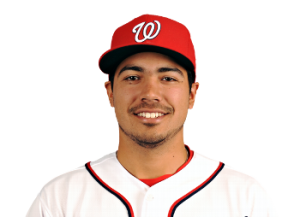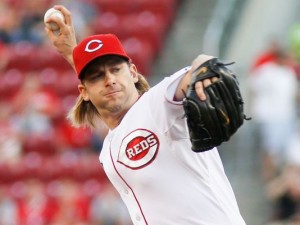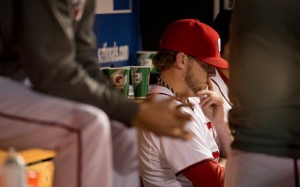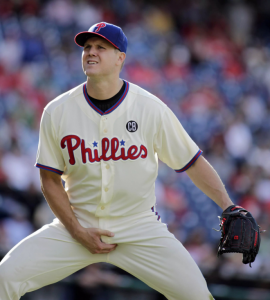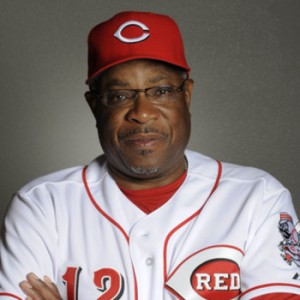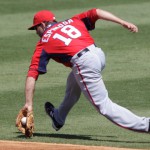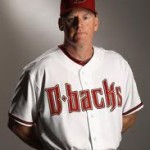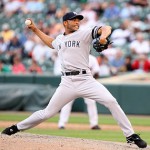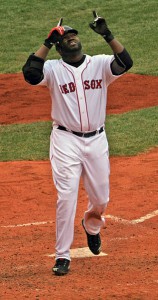Wow, no inboxes for months and suddenly two in two weeks?? It must be spring training! This is great! MLB.com’s Nats beat reporter Bill Ladson on 2/20/16 has published more reader questions. Here’s how I would have answered them.
Q: Without a doubt, Bryce Harper will be the best hitter on the Nationals this year. Who do you see as being the second-best hitter on the team?
A: Anthony Rendon. If this team is going to win in 2016, Rendon needs to return to form. Everyone else at this point in the lineup will be a table setter for Rendon and Harper. Ladson says Zimmerman, who I admit i’ve begun to lose faith in.
Q: How does the front office justify bringing back Jonathan Papelbon after what happened last year with Harper? Papelbon has proven time and again that he is not a good teammate, yet he’s back for 2016?
A: I guess the questioner didn’t know that Papelbon was still *signed* for 2016. So it wasn’t so much about “bringing him back” on purpose as it was the team “not being able to get rid of him.” I put the Papelbon acquisition as one of the worst of the Mike Rizzo tenure; not so much for who we gave up (a good but not game changing prospect in Nick Pivetta) but for the incredible mis-calculation of the acquisition’s affect on the rest of the team. I’m sure the team desperately tried to move him in the off-season but (with echos of “Lerner’s are cheap” abounding) probably weren’t willing to dump him for no return. So here we are; its 2016 and Papelbon is here in lieu of the home grown popular (and team union rep) Drew Storen.
I’ll bet Rizzo doesn’t make this mistake again.
Nonetheless, Papelbon said the right things in his first media interviews since the interview, actually managing to appear humble and contrite while talking about how he was in the wrong and flat out apologizing to the fans. I say good for him; even I couldn’t help but applaud his performance last last week.
Ladson says the team “made a good decision” in not moving Papelbon; yeah right. If they could have gotten *anything* for him he’d be gone. You worry about “finding a closer” in the current bullpen? Uh, how about anyone? We don’t need to go into more historical reviews of the uselessness of closers vis-a-vis teams holding leads after 8 innings.
Q: Why did the Nats not re-sign Craig Stammen? Before last year, I thought he did a great job as a middle reliever.
A: It all came down to risk mitigation. Stammen absolutely did a great job for this team for many years … but he’s got a lot of innings, is coming off of a season-long injury, has (to be fair) rather funky mechanics, and the team just couldn’t justify guaranteeing him what probably would have been $2.5M or so for the unknown. The industry felt the same way: Stammen ended up with a non-guaranteed minor league deal with Cleveland instead of either a major league deal or anything of significant value. Trust me I was bummed; we met Stammen years ago at a golf event and he was awesome; hate to see these long-time Nats leave. Ladson basically says the same thing.
Q: Don’t you think it’s time to improve left field? Jayson Werth is not the player he used to be. He makes a lot of money and doesn’t provide much in return.
A: And do what with Werth? Magically trade him for valuable assets and get his payroll off your books? The asker clearly thinks that the rest of the league are run by morons and the Nats can just magically get rid of the likes of Werth for value. Yes he’s costing you more than 10% of your payroll. It is what it is; veteran FA contracts all end up like this. Honestly, I think Werth still has a ton of value if you use him properly; that means batting lead-off where you take advantage of his high pitches-per-plate appearance and high OBP. We’ll see if Dusty Baker thinks outside the box like this (doubt it). Ladson says Werth is a comeback player of the year candidate.
Q: What are the chances the Nationals make a trade for someone like Carlos Gonzalez to protect Harper in the lineup?
A: I like Carlos Gonzalez … but his home/away splits are pretty distinct. .972 OPS in Denver, .758 OPS elsewhere last year. I’m not sure he’s anything more than a mediocre outfielder if he’s not playing half his games at altitude. Besides, the team made its play for the outfield when they acquired Ben Revere. Ladson thinks Rizzo could still “make a deal for a slugger” during Spring Training if he doesn’t like what he sees. Uh; trading season is over, dude. How many big-time sluggers can you think of that moved in spring training?
Q: A prime component of the Mets’ rotation is the ability to throw hard and get a bunch of strikeouts, but how unique is the Nationals’ rotation and how could it help them win the NL East next season?
A: Indeed, the Mets have a plethora of big-time arms throwing big-time heat. But the Royals buzzed through their staff with ease in the World Series. Why? Because the Royals were the best team in the league for not taking a strikeout and putting the ball in play. So once it became apparent that the Mets starters couldn’t close out games by themselves, the Royals (with their superior bullpen) outlasted them. So Ks are important but not the end-all/be-all.
What makes the Nats rotation unique? Two part answer for me: they (still) have one of the best 1-2 punches in the league in Scherzer and Strasburg. What other 1-2 starters would you take over them? So then past their 2 aces, they have three other guys who are dangerously under-rated. Gonzalez was a Cy Young finalist just a couple years ago and he still has the same stuff. Ross is a complete find, a guy who would be most teams’ #2 starter this year despite just having a handful of MLB starts. And (as often repeated) Roark was a 5-win guy two years ago. So the potential is there for this to be a top rotation end-to-end.
How does the Rotation help them win the NL east? By staying healthy, pitching to potential, and outlasting the Mets own powerful rotation when its crunch time.
Ladson doesn’t really give much of an answer here. He just says what he’d like to “see” each of our starters do this year.
